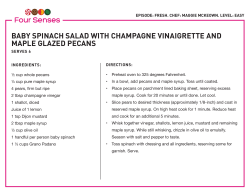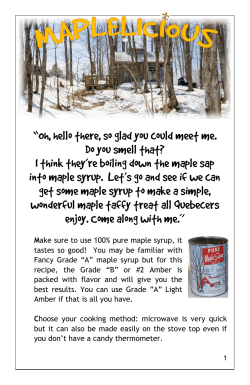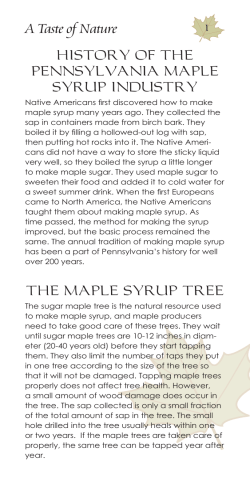
Maple Syrup A Taste of Nature
F ROM T H E WO O D S Maple Syrup A Taste of Nature College of Agricultural Sciences • Cooperative Extension AN EDUCATIONAL SERIES ABOUT FORESTRY FOR YOUTH T here are many different kinds of trees in Pennsylvania’s forests, but the sweetest tree in Pennsylvania is the sugar maple. The sap from this tree is used to make pure maple syrup. M They boiled it by filling a hollowed-out log with sap, then putting hot rocks into it. The American Indians did not have a way to store the sticky liquid maple syrup very well, so they boiled the syrup a little longer to make maple L E S A P S U G A R Sugar maples grow best in these areas of Pennsylvania. Sugar maple trees are unique to North America and grow naturally only in the northeastern United States and southeastern Canada. This makes maple syrup a very special product we get from Pennsylvania forests. HOW IT STARTED American Indians first discovered how to make maple syrup many years ago. They collected the sap in containers made from birch bark. sugar. They used maple sugar to sweeten their food and added it to cold water for a sweet summer drink. When the first Europeans came to North America, the American Indians taught them about making maple syrup. As time passed, the method of making maple syrup improved, but the basic process remained the same. The annual tradition of making maple syrup has been a part of Pennsylvania’s history for well over 200 years. Students get a first-hand look at dripping sap from a tapped sugar maple tree. MAPLE SUGARING BASICS In early spring each year, maple producers, also called “sugarmakers,” throughout Pennsylvania head to their woods for the start of the maple syrup season. Generally, the maple season lasts from mid-February to early April. Maple producers drill a small hole into the trunk of the tree. This is called tapping. They insert a small Photos 1–4 show tapping a tree (1) and using tubing to collect the dripping sap (2,3) into a storage tank (4). 1 2 3 4 What does a sugar maple look like? The sugar maple leaves are 3” to 5” in diameter with five lobes and pointed teeth on the edges. spout or spile to catch the sap that begins to collect in the hole. The spout may connect to plastic pipes stretching through the woods, called tubing, or to a bucket to collect the dripping sap. The sugar maple tree can grow to 100’ tall and have a trunk diameter of 2’ to 4’. heals within one or two years. If the maple trees are taken care of properly, the same tree can be tapped year after year. MAKING THE SYRUP Sap from the sugar maple tree is about 98 percent water and THE MAGIC TREE The sugar maple tree is the natural resource used to make maple syrup, and maple producers need to take good care of these trees. They wait until sugar maple trees are about 10 inches in diameter (20 to 40 years old) before they start tapping them. They also limit the number of taps they put in one tree according to the size of the tree, so that it will not be damaged. Tapping maple trees properly does not affect tree health. However, a small amount of wood damage does occur in the tree. The sap collected is only a small fraction of the total amount of sap in the tree. The small hole drilled into the tree usually Sugarmakers grab wood to feed the fire under an evaporator to boil sap. 2 percent sugar, other nutrients, and minerals. To make pure maple syrup, the sap needs to be boiled to evaporate a lot of the water away. Maple syrup is 33 percent water and 67 percent sugar. The sap starts to “run” or flow out of the holes when the weather is just right. Sugarmakers like cold nights (with temperatures below freezing) and warm days (with temperatures above freezing) so the sap will flow. Once the sap starts collecting in the buckets or flowing through the tubing, it needs to be processed right away. Sugarmakers use evaporators to make maple syrup. An evaporator consists of two or more large, specially designed pans that are filled with sap. These pans sit over a fire of burning wood or some other TREE SAP 98% Water 2% Sugar MAPLE SYRUP 67% Sugar 33% Water Sugar content of raw tree sap and processed maple syrup. fuel, which heats the sap and causes it to boil. As it boils, some of the water in the sap IT TAKES ABOUT 40 GALLONS OF SAP TO MAKE JUST ONE GALLON OF PURE MAPLE SYRUP! 40 GALLONS SAP ➔ 1 GALLON SYRUP turns into steam, which rises out of the sugarhouse. The sap becomes thicker and sweeter. The sugarmaker has to watch the boiling sap very carefully because it could easily burn in the evaporator. As the sap thickens, it gets hotter. The sugarmaker knows that the maple syrup is ready when its temperature reaches 7 degrees Fahrenheit above the boiling point of water. This process requires a lot of time and energy, because it takes about 40 gallons of sap to make just one gallon of pure maple syrup! tered to take out “sugar sand,” which accumulates as the sap boils. Sugar sand is just minerals and nutrients that concentrate as the excess water is boiled away. If it is not filtered out, the maple syrup will appear cloudy. THE FINAL PRODUCT After the maple syrup is filtered, it is put in a container for sale, or made into other tasty maple treats. Many maple producers process their maple syrup into maple sugar, maple candy, maple cream, and even maple jelly. Pure maple syrup and other maple products have no additives, preservatives, or artificial colors. It’s all natural, and some people even call it a “taste of nature.” Pure maple syrup is great on pancakes, waffles, and French toast. You can also enjoy it on vanilla ice cream, on steamed rice and vegetables, or other foods. It is a pure, all-natural product from Pennsylvania’s woods. The boiling sap is tested with precise instruments to determine if it is maple syrup. If it is thick enough to be maple syrup, it is fil- Prepared by Anni Davenport, former extension assistant in forest resources; Sanford Smith, natural resources and youth specialist; and Roy Adams, former associate professor of wood products. Support for the printing of this document was provided by the U.S. Forest Service, the Department of Conservation and Natural Resources, and the Pennsylvania Bureau of Forestry. This publication is available from the Publications Distribution Center, The Pennsylvania State University, 112 Agricultural Administration Building, University Park, PA 16802. For information telephone (814) 865-6713. Where trade names appear, no discrimination is intended, and no endorsement by Penn State Cooperative Extension is implied. Issued in furtherance of Cooperative Extension Work, Acts of Congress May 8 and June 30, 1914, in cooperation with the U.S. Department of Agriculture and the Pennsylvania Legislature. T. R. Alter, Director of Cooperative Extension, The Pennsylvania State University. This publication is available in alternative media on request. The Pennsylvania State University is committed to the policy that all persons shall have equal access to programs, facilities, admission, and employment without regard to personal characteristics not related to ability, performance, or qualifications as determined by University policy or by state or federal authorities. The Pennsylvania State University does not discriminate against any person because of age, ancestry, color, disability or handicap, national origin, race, religious creed, sex, sexual orientation, or veteran status. Direct all inquiries regarding the nondiscrimination policy to the Affirmative Action Director, The Pennsylvania State University, 201 Willard Building, University Park PA 16802-2801; Tel. (814) 8654700/V; (814) 863-1150/TTY. © The Pennsylvania State University 2000 10M1/00NVO
© Copyright 2026










